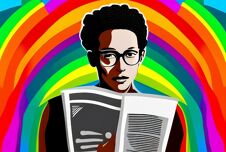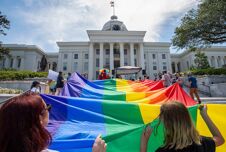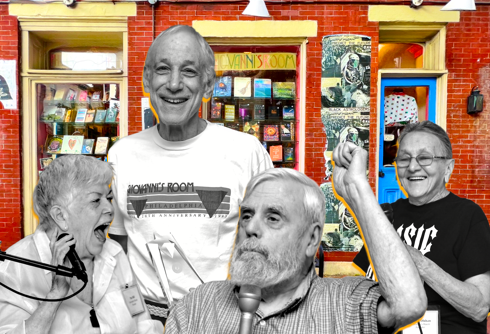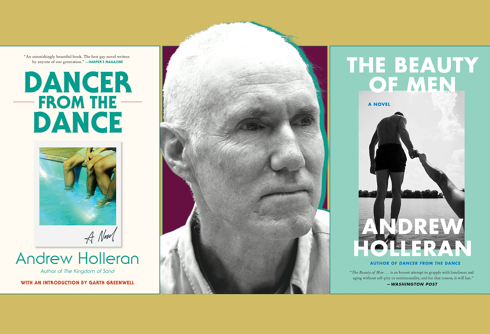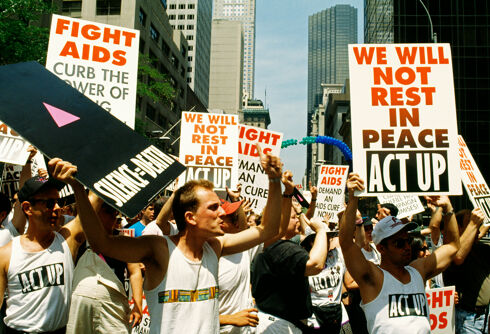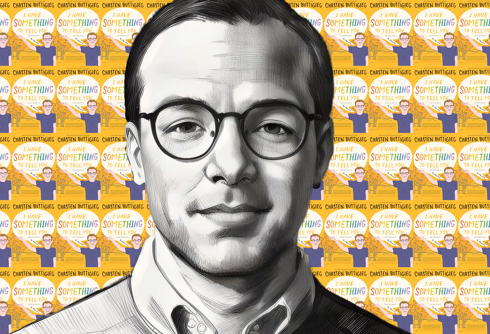“I can feel it around me. Energy. So many different types of energy,” DC Comics’ Jules Jourdain notices as yellow, orange, and pink vibrations envelop him on a street corner, only visible thanks to their special powers.
“I still look the same on the outside,” Jules considers. Even though he’s gaining a reputation as the new superhero Circuit Breaker, the trans and nonbinary character (he/they) doesn’t yet know how to control the overwhelming power coursing through his body — it mostly just makes him feel isolated, scared, and dangerous.
Luckily, another well-known DC Comics superhero, The Flash, arrives and helps Circuit Breaker use his powers to control time and space. This isn’t the mainstream version of The Flash that most people know from old comics, TV, and film. They’re Jess Chambers, a non-binary variant of the well-known hero, just one of the many queer superhero variants that exist in the DC Comics multiverse.
Jourdain explains their trouble to The Flash: “Life or death… change or stasis… control or submission… man or woman. Thinking in binaries always feels limiting to me,” he says. The Flash encourages him not to overthink it, but to trust his intuition and let his power lead him from the inside.
Finally, having mastered his powers, The Flash takes him to a dance club. There, Circuit Breaker dances shirtless alongside his leather-clad friends — happy for the first time since coming out as a superhero. There, Jourdain realizes, “With the death of the old comes a chance at the new.”
In the real world, conservatives tell queer youth like Jourdain that they’re mentally ill and that books about their experiences “sexualize” and “indoctrinate” other kids just by existing.
Never Miss a Beat
Subscribe to our newsletter to stay ahead of the latest LGBTQ+ political news and insights.
Over the past two years, conservatives have increasingly focused on comic books and graphic novels with LGBTQ+ content. “Parents rights” advocates have targeted titles like Maia Kobabe’s Gender Queer: A Memoir, Alison Bechdel’s Fun Home, Alice Oseman’s Heartstopper, and other queer-themed graphic works for removal from schools and public libraries.
Censors have long accused comic books of corrupting young people. American psychiatrist Fredric Wertham’s 1954 book Seduction of the Innocent, which blamed comic books for causing juvenile delinquency, resulted in a moral panic that compelled publishers to establish the self-censoring Comics Code Authority (CCA). The CCA forbade comics from any negative depictions of government as well as depictions of “gore,” “nudity,” “profanity,” or “sex perversion.”
Individuals who seldom encounter LGBTQ+ people or queer stories may interpret inclusive comics as indoctrination, finding it hard to “embrace what they don’t see,” gay comic book and young adult writer Rex Ogle told LGBTQ Nation. “[These people] lash out. And books are an easy target.”
If young readers and free-speech advocates are holding out for a hero, DC Comics, one of the United States’ oldest and largest comic book publishers, might just be the streetwise Hercules they need. In the past year, the powerhouse publisher behind such iconic heroes as Superman, Batman, and Wonder Woman has quietly stood behind and even increased its LGBTQ+ content.
Over the past several years, DC Comics has used its deep multiverse to introduce queer and gender-swapped variants of longtime characters like Superman (Jon Kent), Green Lantern (Sojourner Mullein), Aquaman (Jackson Hyde), and the Flash (Jess Chambers), as well as introducing new LGBTQ+ characters like Galaxy, Xanthe Zhou, and Circuit Breaker. Additionally, DC Comics’ multiverse sometimes results in different individuals assuming the same superhero identities on different timelines or universes, such as when Damien Wayne and Tim Drake both fight crime as Batman’s sidekick, Robin.
In June 2023, the company released a slew of new and re-issued material as part of its Pride Month offerings, including DC Pride 2023, its third annual Pride-themed anthology of new material. Two other releases – DC Pride: The New Generation and DC Pride: Through The Years – contain landmark queer-themed work with most of the writing and artwork by LGBTQ+ creators. The diversity of voices and visual styles make a strong case for the form – with its marriage of words and images – as a riveting place to discover contemporary queer storytelling.


DC Comics’ continued production of queer content feels especially important in an era when several large corporations have reconsidered (or outright scaled back) their outward commitments to LGBTQ+ communities in response to conservative boycotts and media pressure seeking to make LGBTQ+-allyship “toxic” to companies’ brands.
DC Comics’ releases provide a powerful reminder that comic book characters reflect more than just corporate trademarks. Superheroes can serve as symbols to help readers understand abstract concepts like justice, empathy, dignity, and diversity. And who doesn’t want to see themselves – or someone like them – as the hero of the story? For most of these narratives, representation is just the start. Some contain LGBTQ+ characters fighting bigotry, while others show queer heroes finding community in a classic team-up. For many younger characters, coming to terms with their powers draws a relatable parallel to the exploration of sexual and gender identity.
Young queer people often find agency and comfort in these dynamic and colorful stories, especially since they don’t always feel supported in their homes, schools, offline, and online communities. According to Dr. Jonah DeChants, a research scientist at The Trevor Project, “Recent political attacks aimed at transgender and nonbinary youth have not only threatened their access to health care, support systems, and affirming spaces at school, they’ve also negatively impacted their mental health.”
In addition to inspiring young people, some of DC Comics’’ recent LGBTQ+ stories also have a broader cultural impact. Some right past wrongs by giving killed, neglected, and forgotten characters a second chance. Others feature tributes to recently deceased LGBTQ+ pioneers of superhero storytelling, like gay actor Kevin Conway and transgender author and activist Rachel Pollack.
These themes explore what it means to be queer in a quarrelsome world and how real-life super-queeroes can survive, thrive, and cultivate their unique abilities and identities to become heroes in their stories.
Redefining ‘Justice for All’

In addition to the 500+ anti-LGBTQ+ bills introduced at state and local levels during the 2023 legislative session, reported hate crimes based on gender and sexual sexuality have steadily increased since 2014, rising by 70% between 2020-2021.
Phil Jimenez, one of the first out gay comic book writers and artists at DC Comics, in his introduction to DC Pride 2023, questions how to position anti-LGBTQ+ narratives in Superman or Wonder Woman’s universe. How would established queer heroes, anti-heroes, and villains respond to such attacks? Would pursuing “justice for all” seem like activism in that world or “just the right thing to do”?
Several writers in the DC Pride releases tackle this question by telling stories about the symbolic importance of having publicly out LGBTQ+ superheroes.
In “Super Pride (originally published in 2022), Jon Kent (Superman’s son) and Robin (Damien Wayne, Batman’s son) attend their first Pride march.
Robin prepares for the parade by bringing smoke bombs, electrified netting, and electromagnetic pulse generators because a community under political attack is “vulnerable to literal attack,” he argues.
On the other hand, Jon attends the parade in his Superman outfit but with a cape of different Pride flags. He says the iconic “S” shield symbolizes the hope and the possibility of making the world a better place. But for today, he tells his boyfriend, “I want [Pride] to mean that I see you. That I am you. That there’s no wrong way to be yourself.”
With that encouragement, Jon flies above the Pride-going crowd and creates a rainbow. Nick Robles’ artwork and Triona Tree Farrell’s vibrant color palette make the moment pop with joy.
Though endearing, the interaction almost feels like it comes from another era. In its annual crime report for 2022, the FBI noted a 19% increase in anti-LGBTQ+ incidents compared to 2021. Anti-transgender bias crimes increased by 35% overall. It’s no wonder that the Human Rights Campaign (HRC) declared a state of emergency for LGBTQ+ Americans during Pride Month last June.
Maybe Damien Wayne’s fears weren’t too far off the mark.
Compared to “Anniversary,” Josh Trijullo’s story published in DC Pride 2023, one gets a sense of how superheroic advocay has shifted over recent years.

“Anniversary” features married gay superhero couple Midnighter and Apollo considering their visibility as LGBTQ+ role models during their wedding anniversary. Don Aguillo’s expressive, painted artwork follows the duo as they mentor a group of drag queen vigilantes, visit the iconic Stonewall Inn, and step into the middle of a tense LGBTQ+ rights protest and counter-protest on the steps of the U.S. Capitol.
Midnighter wants to bust skulls, while Apollo worries that the violence will spread. They’re joined by Alan Scott, the WWII-era Green Lantern, who advocates a more measured response, lecturing them on the history of LGBTQ+ civil rights. He encourages the couple to think of themselves as “more than costumed mystery men.”
Agreeing that visibility and pride are ways to start fighting back, the couple goes one step further, adopting a hacktivist approach. They remarry on the spot, broadcasting the ceremony to every conservative news network and social media channel they can jam in the DC universe.
One important thing hasn’t changed in the year between these stories’ publications: the underlying faith that comic book superheroes function best as symbols. But maybe it’s not enough just to be a symbol anymore.
In his book Understanding Comics, Scott McCloud notes that comic books reinvent new symbols regularly in response to a changing society. Maybe some of these new superheroic symbols just give older ones new purpose and direction.
DC Comics’ take on chosen family

Not only has the increase in anti-LGBTQ+ rhetoric and legislation negatively affected 66% of LGBTQ+ teens and young adults’ mental health, but only 38% consider their homes as LGBTQ+-affirming spaces.
To fill the gaps of mutual support and love, many queer people cobble together a chosen family of non-biological kinship as a vital way to thrive. This search for a chosen community forms a key part of several of the DC Pride team-up stories, a convention in which two characters who typically appear independently take on a challenge together. In fact, some of the more interesting team-up stories gently subvert the conventions of this classic comic book staple in surprisingly queer ways.
The 2021 story arc of Robin (Tim Drake) acknowledging his bisexuality made national headlines. But writer Nadia Shammas’ “Hey, Stranger” picks up on Drake’s journey, flipping the traditional superhero team-up story to show that you never really stop coming out, even to those closest to you.
“Hey, Stranger” marks the first official meeting of Tim and Connor Hawke — a young asexual, BIPOC martial artist who calls himself Green Arrow — since each first discovered their individual queer identities.
This team-up is unusual in that it happens after Tim finishes battling some thugs. Bruka Jones’ artwork depicts a series of quiet but intense moments as the two characters test (and ultimately reaffirm) the value of their friendships, while Tamra Bonvillain’s dawn-tinged palette underscores the story’s emotional weight.
Another team-up story that plays with finding community appears in Jeremy Holt’s “Lost & Found,” featuring the new character Xanthe Zhou. As a nonbinary Chinese-American “spirit envoy” trapped in the realm of the living, they literally exist between several worlds and are unable to find their place. A magician and trickster, they conjure useful spirit world objects by burning small pieces of folded joss paper.
Like the team-up in “Hey, Stranger,” the fighting becomes secondary to the bigger story. Xanthe encounters Batwoman (Kate Kane) in a Gotham City graveyard, defending the Kane family mausoleum from would-be thieves. After trying to help, they listen to Kate mourn her mother’s death that occurred during her childhood.
Smitten, Xanthe gives Kate a folded joss paper tree to burn and shares their insight about the cycles of life and death, healing and rebirth. Leaving Kate in thought, Xanthe realizes they may have a place in the world after all.
In some stories, fighting villains becomes a metaphor for desire. Since depictions of healthy queer intimacy remain rare in visual media, it’s important to recognize that some queer heroes can be lovers as well as fighters.
Queer writer Stephanie Williams’ “Confessions” presents a sly and sultry take on this dynamic. In it, Nubia, Queen of the Amazons, recounts a “forgotten” team-up as pillow talk with Io, her beloved consort. The fight — in this case, a tag-team charity wrestling match for a women’s shelter — includes the aptly named Justice League giantess Big Barda as her teammate.

Rex Ogle’s “The Dance,” drawn by Stephen Sadowski, also provides erotic subtext and a steamy twist on the superheroic team-up with a queer homage to every Batman/Catwoman rooftop tangle since the pair first met way back in 1940. The story features anti-hero Catman (Thomas Blake) and Ghost-Maker (Khoa Khan, from Batman Inc.) fighting baddies together on a Gotham City rooftop.
Sadowski’s fight sequences, full of kinetic pencil work and thicker inks, seem well choreographed. The push-and-pull dynamic between Khoa and Blake makes the pair’s familiarity with one another’s bodies exceedingly clear — and it’s just as clear where they’ll head after the fight.
“I wanted the conflict to marry the sensuality of the body,” Ogle explained to LGBTQ Nation. “We’ve seen the tension between Batman and Catwoman forever, so I wanted to show another coupling.”
In one final glorious splash page, the erotic subtext of the superhero team-up gets revealed at last in all its naked queer glory as Catman and Ghost-Maker embrace in bed.
When a growing sense of queer identity & superpowers converge

For many LGBTQ+ people, the closet remains a lonely and fearful place. Within superhero stories, the isolation that comes from having superpowers is an experience that has often functioned as a metaphor for the isolation of closeted life.
Marvel’s X-Men may have started as five white prep school kids from suburban New York, but, as comics critic Sara Century notes, queer readers could easy to see mutants through the lens of LGBTQ+ civil rights. Their powers make them different, which, in turn, makes them the targets of hate and bigotry. Some could pass as common humans; others couldn’t. But until a decade or so ago, few of the X-Men had actually come out. The X-Man Northstar came out in 2002, and the better-known Iceman made national headlines when he came out in 2015.
Comparatively, some of the most interesting Pride-themed releases from DC Comics move beyond easy metaphors by focusing on how the closet and the coming out process shape the ways in which heroes use their wondrous abilities.
Greg Lockard’s “Public Display of Electromagnetism” suggests that the closet can provide a place where queer kids begin to develop self-reliance. For a younger hero like The Ray (Ray Terrell), the closet’s isolation felt both figurative and literal. The character still wrestles with the trauma of his parents literally confining him in a dark room, away from others, so that his light-based powers won’t manifest.
While he’s out to his Justice League teammates, Ray still melts down when his boyfriend kisses him in front of them. He overcompensates during a subsequent fight with the villain Shadow Thief, who easily overwhelms him with a wave of darkness, snuffing out Ray’s powerful photon charges. Although Ray finds himself reliving the trauma of his closeted youth, he digs into the root causes of his inner darkness to find the inner spark that allows him to harness his powers, shatter the Shadow Thief’s trap, and save the day — after all, Ray still needs to return his boyfriend’s kiss.
Aquaman (Jackson Hyde) also faces a history of negotiating the caped closet in Alyssa Wong’s “A World Kept Just For Me.” In this melancholy story, Jackson shows his boyfriend the small desert town in New Mexico where he grew up. Like Ray’s parents, Jackson’s single mother kept him far away from anything that would trigger his water-bending abilities.
Jackson’s story illustrates queer resilience. His powers developed in tandem with his growing sense of queer identity. He’d practice them in the shower to avoid unwanted attention while publicly struggling to become what he felt his mother wanted: “Normal, Unassuming. Human. Straight.”
Yet, as Jackson shares the pain of his closeted life with his boyfriend, he realizes that those experiences shaped the sense of morality and justice that makes him a hero.

Compared to other characters, Circuit Breaker (Jules Jordain) is the new kid on the multiversal block. Hailing from the playas of rural Nevada, the ability to sense and absorb kinetic energy from the world around them paints a decidedly queer picture.
Jules’ second comic book appearance in “Subspace Transmission” (DC Pride 23) functions as a kind of queer superhero origin story, with writer and artist A.L. Kaplan wisely focusing on the best part: the hero discovering who they are and what they value in relation to their new abilities.
Strange and overwhelming at first, Jule’s powers are a conduit for entropy, the ability to sense and steal kinetic energy and reduce the world to stillness. As they struggle for control over their powers, Jules recalls the fears faced when coming to terms with their gender identity and body while transitioning.
“Bodies are mutable,” Jules realizes after another failed attempt to harness their abilities. “Life or death. Stasis or change. Control or submission. Man or woman. Thinking in binaries always felt limiting to me.” And with that insight, they come to peace with the strangeness of their new abilities.
It is in these moments that Kaplan’s artwork shines. As they explore their powers, the waves of energy swirling Jules evoke psychedelic posters and 1970s rock album art.
For decades, LGBTQ+ comic book fans could only see themselves as metaphors rather than well-rounded queer characters. Being queer may not be a superpower in itself, but it provides LGBTQ+ characters in the multiverse with unique perspectives on their extraordinary abilities. It also provides affirms that our lived experiences matter — maybe that awareness itself is the real superpower.
Dismantling old tropes
E is for Extraño: 1st appearing in 1988, Extraño was the 1st openly gay hero in mainstream comics, BUT "Extraño embodied nearly every stereotype of a gay man […] used as comic relief, and he never had a boyfriend". He's doing much today! #LGBTHM22 #AtoZfLGBTQComics https://t.co/arpWFk1uTv pic.twitter.com/a9F1ahOQih
— Jack Shoulder, but festive ☃️🏳️🌈🏳️⚧️🔺 (@jackshoulder) February 5, 2022
Comic books haven’t always been kind to queer characters. Consider Extraño, DC’s first openly gay superhero. First appearing in 1987, when industry standards prohibited writers from using words like “gay” and “homosexual,” Extraño became a pastiche of stereotypes.
Early stories depicted Extraño as a sassy Peruvian sorcerer whose architectural hair, flowing purple robe, and pirate boots made him look like Liberace cosplaying Doctor Strange. The character all but vanished a year or so later, but only after contracting HIV from an “AIDS vampire” called the Hemo-goblin. No, really.
Extraño’s fate became a textbook case of “bury your gays,” a storytelling trope that remains alive and well in current pop culture (just watch It: Chapter Two and cringe at the gay-bashing scene). But now, queer writers are digging those bodies back up and giving them new life.
In a terse Substack post from May 2022, nonbinary writer Grant Morrison took aim at writers who use alternate versions of major characters as cannon fodder. For them, burying queer characters “for no defensible reason” deprives them of their storytelling potential.

One of the architects of the DC Comics multiverse, Morrison has created several LGBTQ+ and gender-swapped versions of major heroes in recent years. One of them, Red Racer (an alternate version of The Flash), was revealed to be happily married to his universe’s Green Lantern equivalent. Morrison had established the character as a founding member of a multiversal Justice League. However, Red Racer died in a Superman comic book, sacrificing his life to save the title hero.
In “Love’s Lightning Heart” (the lead story in DC Pride 2023), Morrison sets out to rectify this loss. The result provides a trippy, high-concept story of love overcoming death. It follows Flashlight, Red Racer’s grieving husband, on a mad, universe-breaking quest to return his beloved to the living. The story takes the reader on a whirlwind tour of an Art Deco-infused parallel universe and suggests that Red Racer’s return may herald the start of a new story arc brimming with possibilities.
Other LGBTQ+ writers strive towards the same goal as Morrison by reviving queer characters who have been buried, depowered, disfigured, or just plain forgotten. In Christopher Cantwell’s “My Best Bet” (DC Pride 2023), the wily magician and conman John Constantine plays a long game with Superman (Jon Kent) to rescue the soul of Oliver, a former boyfriend who had been dragged to Hell in the final issue of Constantine’s 2015 solo series and ignored … until now.
Queer villains get dug up and dusted off, too. Cannon and Saber — the antagonists in Rex Ogle’s story “The Dance” — have been depicted as an openly gay couple since their first appearance in 1984, but they last appeared over 30 years ago — welcome back, boys!
Even Extraño has returned from the comic book dead. Writer Steve Orlando reintroduced the character in his 2017 GLAAD Media Award-nominated series Midnighter and Apollo. Since then, Extraño has become a mentor for younger queer characters and the founder of a network of LGBTQ+ superheroes called Justice League Queer.
But don’t call him Extraño. Nobody has done that in years. “I’ve since buried that name,” he tells Midnighter, seeming to hint that he does the same to anyone who uses it. Now Gregorio de la Vega, he’s reclaimed his proud place as the first out queer superhero in the DC multiverse.
Grappling with justice & legacies reimagined

In an interview with Lambda Legal, queer poet and essayist Kay Ulanday Barrett argues that stories by and for LGBTQ+ people “honor our grief” as well as “help us remember our glory and community triumphs.” Recent book bans and content challenges seek to erase those histories. The DC Pride releases counter that threat by honoring the legacies of two recently deceased groundbreaking queer elders.
Related:
Book banners came for this Colorado town. They didn’t anticipate resistance.
LGBTQ+ titles topped the number of book bans in the past year, but a growing number of grassroots organizations are rewriting the story.
Rachel Pollack, who passed away from non-Hodgkin lymphoma last April, is best known for her beautiful, strange, and spiritual run on Doom Patrol in the early 1990s, in which she introduced Kate Godwin, a trans lesbian superhero who went by the name of Coagula. Kate was the first — and for nearly two decades — the only transgender superhero published by DC Comics.
A former sex worker, Kate gained the ability to turn liquids into solids (and vice versa) after she spent a night with multi-gendered energy being Rebis. She initially tried to join the Justice League, but they rejected her. “I suspect they liked my powers,” she tells a friend, “but couldn’t handle me.”
Kate soon found her chosen family with the Doom Patrol, a collection of wounded heroes and superpowered outsiders whose adventures bordered on the surreal.
Pollack had been invited to contribute new material to DC Pride 2023, but the sudden progression of her illness prevented this. Instead, the anthology features tributes to her legacy from industry giants like Neil Gaiman and upcoming talents like transgender writer Jadzia Axelrod.
Gaiman reveals that Pollack created Kate Godwin as a response to Wanda Mann, a sympathetic but doomed transgender character in his Sandman story arc “A Game of You.” (Wanda will likely appear in the second season of Netflix’s adaptation, The Sandman.)
For Axelrod, reading that first comic with Kate Godwin in 1993 felt “like a lightning bolt from heaven.” Not only had DC Comics published a story featuring an out trans lesbian, but this smart, funny, kind person became the point of view character for the reader. The comic inspired Axelrod to create a trans-alien superhero named Galaxy, who currently appears in the Hawkgirl comics.
Kate Godwin seldom appeared after Pollack’s run on Doom Patrol ended. Another writer seemingly killed her off-panel a decade later.
However, Coagula may soon return. A trans woman named “Kate” (drawn in Godwin’s signature black tank top and jeans) appears briefly at the start of Axelrod’s 2022 story “Up At Bat” (reprinted in DC Pride: The New Generation). There, Kate runs a wellness group in Gotham City, and serves a friend and mentor to Alysia Yeoh, a trans urban vigilante and Batgirl ally.
What better way to honor Pollack’s legacy than reviving Kate Godwin, recognizing the achievements of these two pioneering women? Maybe the Justice League will finally accept her for her full, authentic self.
And anyone who grew up watching cartoons like Batman: The Animated Series or Justice League Unlimited, can instantly recognize Kevin Conroy’s rumbling, husky voice as Batman. Conroy passed away in November 2022 from intestinal cancer.
Before his death, Conroy collaborated with illustrator J. Bone on the autobiographical graphic story “Finding Batman.” First published in 2022, the story received wide fan acclaim and subsequently won the 2023 Eisner Award for Best Short Story. It also appears in DC Pride: The New Generation.
Conroy writes movingly about the need to maintain a public mask while struggling against homophobia within the entertainment industry while watching his family members succumb to mental illness and substance abuse. In his audition for Batman: The Animated Series, he used these experiences to channel the torment that Bruce Wayne faced as a child, the ones that led him to become a masked vigilante.
Conroy developed a voice from his own traumas that became one of the definitive takes on the character. J. Bone’s artwork – sharp, thick pencils and blue washes – provides a compelling screen for Conroy’s experiences.
“It is nearly impossible to write and draw heroes,” writer Jimenez says, “and not grapple with the very concept of justice and what it means to act heroically.” Although Conroy did not create heroes in the conventional sense, “Finding Batman” suggests that his celebrated portrayal of Batman came from a life of grappling with those same struggles.





